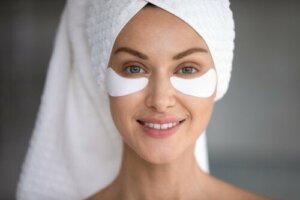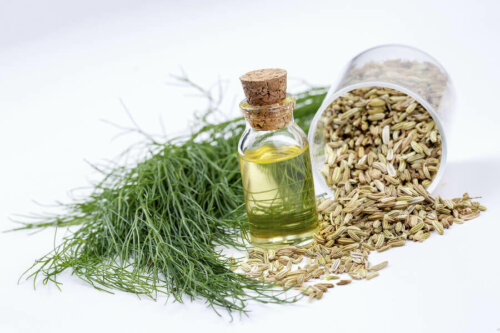How to Get Rid of Bags Under Your Eyes with Oils


Written and verified by the doctor Karla Henríquez
Getting rid of bags under your eyes is a common goal, even if you have good sleep habits, you might still have a shadow under them.
It’s probably annoying to have bags under your eyes. They look like a sign of accumulated fatigue and add years to your face. Although some people don’t pay attention to them, the most common thing is that people want to get rid of them, to look fresher and more youthful.
Here we’ll tell you more about some remedies with essential oils that you can apply on a regular basis.
Bags under your eyes aren’t always a sign of lack of sleep
Maybe you sleep well every night but you might still have bags under your eyes, this could be due to the sensitivity of your skin. There are some natural alternatives to moisturize your entire face, especially the lower eyelid area.
Bags under your eyes are caused by the fact that there are few sebaceous glands under the eyes and the skin tends to dry out in that area. As a result, it becomes more sensitive and, when exposed to the sun, bags are formed and the skin darkens due to excess melanin production.
1. Almond oil

According to data from the Spanish Nutrition Foundation (FEN), almonds contain proteins, monounsaturated fatty acids, unsaturated fatty acids, fiber, calcium, phosphorus, magnesium, iron, zinc, potassium, vitamin E, riboflavin, thiamine, niacin, and folates. All these components are suitable for improving the appearance of the skin and, therefore, for reducing bags under your eyes.
There are bitter and sweet almonds: the latter is the most frequently used in the production of cosmetics and skin treatments.
How to use it
- Wash your face very well so the oil can absorb better
- Place two or three drops on the tip of your finger and apply gently on the bags under your eyes until the skin absorbs it very well
- Be consistent in its application in order to appreciate its contributions
Learn about the Uses for Almond Oil that You Didn’t Know About
2. Get rid of bags under your eyes with argan oil
Argan oil is an antifungal oil chock-full of antioxidants. It moisturizes and softens your skin and hair, as it contains vitamin E and omega 3, 6, and 9 fatty acids. Argan oil is perfect for getting rid of bags under your eyes.
How to use it
- Just like with almond oil, apply three drops of argan oil with your fingertip every night before bed
- Remember to wash your face to make sure it’s free of makeup and contaminants before you apply the oil
3. Fennel seed oil

How to use it
While fennel seed oil is very good for you, it’s not good to use too much. In large quantities, it can be toxic, so use with caution.
- Apply three drops to the dark circles under your eyes, using your fingertip and very gentle movements until the oil is fully absorbed
- We recommend using fennel seed oil at night, 3 times a week max
Important note: if in doubt, it’s best to consult a dermatologist before starting to apply it regularly. Remember that the eye contour area is very delicate and it’s advisable to use the appropriate remedies.
4. Olive oil
Olive oil contains antioxidants. In addition, it’s rich in monounsaturated fatty acids, unsaturated fatty acids, and vitamin E. When used topically, it’s moisturizing and regenerating. It contains high levels of oleic acid.
How to use it
- Apply olive oil compresses to your eye area for a few minutes
- Then remove and leave the oil on overnight
- In the morning, wash your face like normal
5. Rosehip oil

Rosehip oil is one of the most widely used oils in beauty and skincare products. One reason is that it’s rich in fatty acids, antioxidants, and vitamins.
It helps reduce the impact of oxidative stress, nourishes the skin, rehydrates, and lightens the area where it’s applied.
How to use it
- Cleanse your face well to allow the oil to absorb better
- Place two or three drops on your fingertip and apply gently to the skin underneath your eyes
Learn these Five Ways to Make Yourself Look Younger on a Small Budget
6. Lavender essential oil
Lavender oil is amazing: it’s anti-inflammatory, antifungal, antidepressive, antiseptic, and antibacterial. It’s also a natural pain-reliever and detoxifier and has the power to improve your circulation and heal your skin.
How to use it
- Firstly, mix two drops of lavender oil with a bit of water to make a natural remedy for bags under your eyes
- Apply every night before bed and rinse off in the morning
Getting rid of bags under your eyes
Before using any of these oils to get rid of bags under the eyes, you should consult a dermatologist, in case there’s one remedy in particular that could benefit you more than others.
Once you have your dermatologist’s approval, proceed with your skincare routine as instructed.
Additionally, remember you can always apply an ice pack daily, whenever you can, to reduce dark circles under the eyes and achieve a fresher, more rested appearance.
Furthermore, use sunscreen daily on the face and neck. In addition, remember that the skin around the eyes is thinner, so it requires more care.
All cited sources were thoroughly reviewed by our team to ensure their quality, reliability, currency, and validity. The bibliography of this article was considered reliable and of academic or scientific accuracy.
- Ojeras (2007). Victor Martínez.
http://www.atdermae.com/pdfs/atd_30_03_09.pdf - Mayo Clinic Staff. (2014). Bags under eyes.
mayoclinic.org/diseases-conditions/bags-under-eyes/basics/definition/con-20034185 - What causes dark circles under the eyes? (2007). Freitag FM, Cestari TF.
https://www.ncbi.nlm.nih.gov/pubmed/17760701 - Wu B. (2015). Dark circles under the eyes.
dermnetnz.org/topics/dark-circles-under-the-eyes/ -
López Luengo, M. (2004). Los aceites esenciales. OFFARM, 23(7), 88–91.
https://doi.org/10.1117/12.2179560 -
Flores, C. R., Pennec, A., Nugier-Chauvin, C., Daniellou, R., Herrera-Estrella, L., & Chauvin, A. L. (2014). Chemical composition and antibacterial activity of essential oils extracted from plants cultivated in Mexico. Journal of the Mexican Chemical Society, 58(4), 452–455.
-
Luengo, P. (2004). Los aceites esenciales :Aplicaciones farmacológicas , cosméticas y alimentarias . Ámbito Farmaceutico Fitoterapia, 23, 88–91.
https://doi.org/10.1117/12.2179560 -
Cañellas, M., Espada, N., & Ogalla, J. (2008). Estudio del aceite de rosa mosqueta en cicatrices postquirúrgicas. El Peu, 28(1), 9–13.
http://diposit.ub.edu/dspace/bitstream/2445/26072/1/2008280109.pdf
http://diposit.ub.edu/dspace/handle/2445/26072 -
Fito Colomer, M. (2003). Efectos antioxidantes del aceite de oliva y de sus compuestos fenólicos. Tdx.Cesca.Es.
https://doi.org/10.1063/1.2939268 -
Diao, W. R., Hu, Q. P., Zhang, H., & Xu, J. G. (2014). Chemical composition, antibacterial activity and mechanism of action of essential oil from seeds of fennel (Foeniculum vulgare Mill.). Food Control, 35(1), 109–116.
https://doi.org/10.1016/j.foodcont.2013.06.056 -
Sayas Barbera, E., & Kharbouch, A. (2012). Argan oil: source of bioactive compounds. Aceite de Argan: Fuente de Compuestos Bioactivos. Bilbao.
https://www.mendeley.com/catalogue/argan-oil-source-bioactive-compounds/ -
Hernández, S. A., & Zacconi, F. C. M. (2009). Aceite de almendras dulces: Extracción, Caracterización y Aplicación. Quimica Nova, 32(5), 1342–1345.
https://doi.org/10.1590/S0100-40422009000500044
This text is provided for informational purposes only and does not replace consultation with a professional. If in doubt, consult your specialist.








